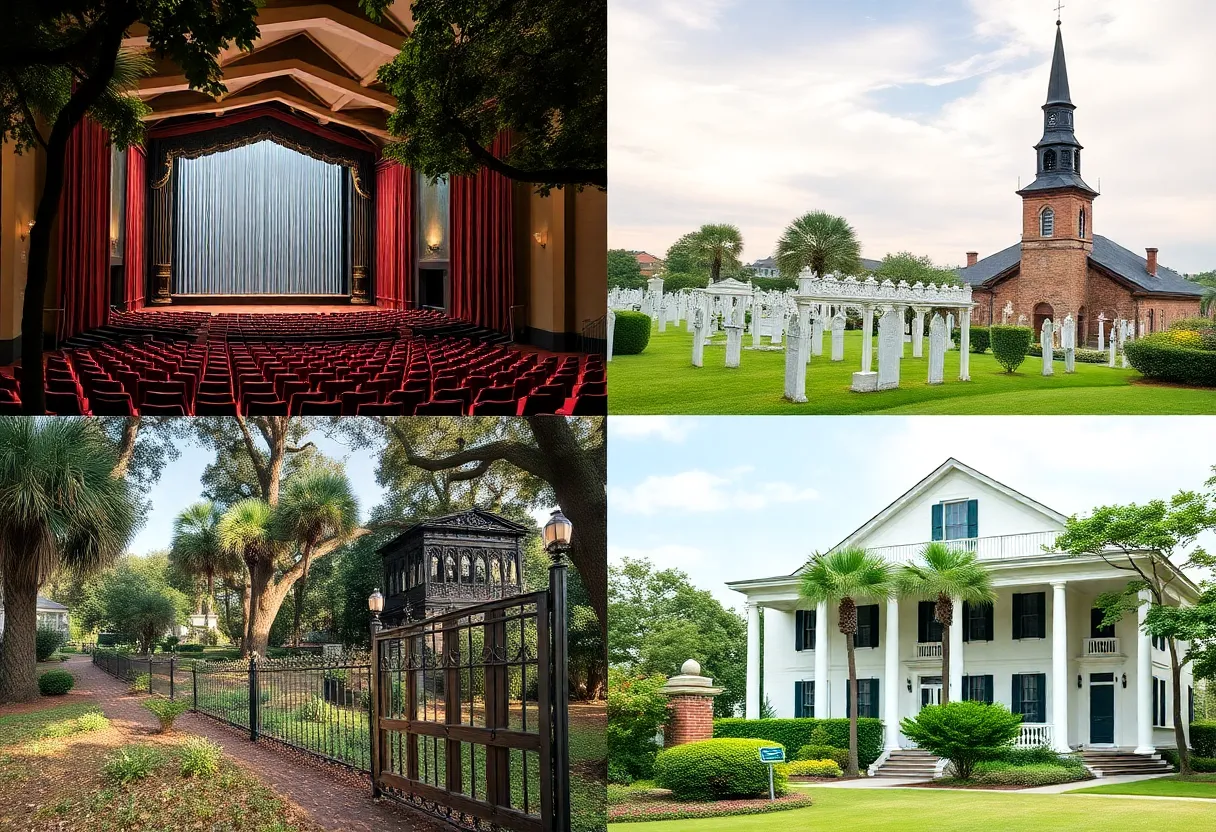News Summary
Charleston, South Carolina, is gaining recognition for its unique attractions highlighted by Atlas Obscura. The city’s rich cultural heritage and history showcase 12 intriguing experiences, further expanded by local insights from the Charleston City Paper. From the historical Dock Street Theatre to the serene Magnolia Cemetery and cultural landmarks like Mosquito Beach, Charleston invites both residents and visitors to explore its lesser-known destinations and their stories.
Charleston Unveils Unique Hidden Destinations
Charleston, South Carolina, is drawing attention for its unique attractions prominently highlighted by Atlas Obscura, a national travel and exploration company. This list features 12 experiences that showcase the city’s rich cultural heritage, history, and art. The Charleston City Paper has expanded this exploration by spotlighting even more lesser-known destinations that locals and visitors alike may find intriguing.
Unique Attractions in Charleston
One of the standout locations is the Dock Street Theatre, known as the first theatre in the 13 colonies, established in 1736. The current structure replaced the original building and was completed in 1809 as the Planter’s Hotel. The theatre holds historical significance due to its connections to the story chronicled in Ilyon Woo’s Pulitzer Prize-winning book, Master Slave Husband Wife, recounting the escape of two enslaved individuals. During the 1930s, the building faced demolition until it was rescued by the Pearlstine brothers, who won it in a poker game. With city support, they restored the theatre, which reopened in November 1937 and now hosts various cultural festivities, including the Spoleto Festival USA.
Historical Significance of Other Locations
The Porgy House, located on Folly Beach, was built in 1933 and served as a summer retreat for author DuBose Heyward, who is notably linked to George Gershwin’s opera Porgy and Bess. The property is currently listed at $3 million but faces threats from rising home values, environmental risks, and the absence of historical protections.
Magnolia Cemetery, established in 1850 and a designated site on the National Register of Historic Places, is the final resting place for many notable historical figures, including civil rights activist J. Waties Waring and former Vice President John C. Calhoun.
Charles Towne Landing is recognized as the birthplace of South Carolina. Visitors can explore interactive exhibits, history trails, and a replica of a 17th-century sailing ship that brings the early colonial period to life.
Preservation of Cultural Heritage
Mosquito Beach has historical importance as a gathering place for Lowcountry African Americans during the Jim Crow era. The Old Slave Mart, which remains the last intact slavery auction house in South Carolina, has been transformed into a museum that sheds light on the state’s tumultuous antebellum past. The historic City Jail also holds stories of notorious figures, including pirates and prisoners from the American Civil War.
Drayton Hall is notable for being the oldest unrestored plantation house open to the public, allowing visitors insight into the architectural styles of past centuries. The Unitarian Church Cemetery is another serene spot that weaves nature with history, showcasing historic graves in a tranquil setting.
Additional Hidden Gems
The Tavern at Rainbow Row reflects a mischievous past intertwined with pirate lore amid the vibrant, colorful rowhouses of Charleston. Notably, Hibernian Hall houses the Giant’s Causeway Pillar from Northern Ireland, a curious artifact for visitors. The Angel Oak tree on Johns Island is famed for its massive size and associated ghost stories, drawing visitors eager to witness its grandeur.
Another fascinating historical piece is the H.L. Hunley, a Confederate submarine involved in a historic naval attack that is now displayed at a museum in North Charleston, serving as a testament to the maritime history of the region. The remnants of Colonial Dorchester, dating from 1697 to the Revolutionary War era, provide insight into early colonial life.
Sullivan’s Island showcases Poe’s Tavern, connecting visitors to the literary lineage of Edgar Allan Poe, while Osceola’s Grave marks the resting place of the renowned Seminole Indian chief. Lastly, the Charleston Tea Garden stands as the only large-scale tea plantation in the United States, offering a unique glimpse into the production of tea in a southern context. The Folly Boat, a quirky local landmark, further epitomizes Charleston’s artistic spirit, having become a canvas for creativity after being washed ashore by hurricanes.
Conclusion
Charleston continues to offer a variety of historic sites, cultural events, and hidden attractions that cater to both residents and visitors seeking exploration beyond the usual tourist path. The city’s diverse and rich history is encapsulated in its lesser-known destinations, inviting everyone to discover their stories.
Deeper Dive: News & Info About This Topic
HERE Resources
South Carolina’s Thriving Tourism Landscape
Additional Resources
- Count On 2 News: Mechanical issue prompts evacuation from United Airlines flight in Charleston
- Post and Courier: Grocery local produce delivery Charleston
- ABC News 4: Charleston commemorates 10 years since tragic church shooting
- Count On 2 News: Charleston Fire Department marks 18 years since 9 firefighters killed in Sofa Super Store fire
- Count On 2 News: Charleston fire to initiate 24-hour watch inside Charleston 9 Memorial Park
- Wikipedia: Charleston, South Carolina
- Google Search: Charleston news
- Google Scholar: Charleston
- Encyclopedia Britannica: Charleston
- Google News: Charleston

Author: STAFF HERE CHARLESTON
The CHARLESTON STAFF WRITER represents the experienced team at HEREcharleston.com, your go-to source for actionable local news and information in Charleston, Charleston County, and beyond. Specializing in "news you can use," we cover essential topics like product reviews for personal and business needs, local business directories, politics, real estate trends, neighborhood insights, and state news affecting the area—with deep expertise drawn from years of dedicated reporting and strong community input, including local press releases and business updates. We deliver top reporting on high-value events such as the Spoleto Festival USA, Charleston Wine + Food Festival, and the MOJA Festival. Our coverage extends to key organizations like the Charleston Metro Chamber of Commerce and the Charleston Museum, plus leading businesses in tourism and maritime industries that power the local economy such as South Carolina Ports Authority and the Charleston Visitor Center. As part of the broader HERE network, including HEREaiken.com, HEREbeaufort.com, HEREchapin.com, HEREcharleston.com, HEREclinton.com, HEREcolumbia.com, HEREgeorgetown.com, HEREgreenwood.com, HEREgreenville.com, HEREhiltonhead.com, HEREirmo.com, HEREmyrtlebeach.com, HEREnewberry.com, HERErockhill.com, HEREspartanburg.com, HEREaustin.com, HEREcollegestation.com, HEREdallas.com, HEREhouston.com, and HEREsanantonio.com, we provide comprehensive, credible insights into South Carolina's dynamic landscape.





